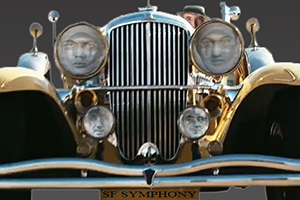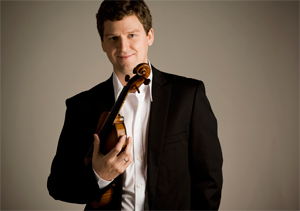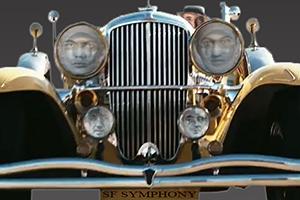
Photo illustration by Jeff Dunn
Five American composers and at least four soloists graced the first subscription concert of the San Francisco Symphony. The audience loved it, even applauding between movements of Samuel Barber's Violin Concerto. For good reason: this orchestra, mostly celebrating music from the 1920s, was as sharp as a chrome gleam from Gatsby’s yellow roadster.
The quality of the orchestra was most evident in the second half of the concert, in George Antheil's crazy-quilt A Jazz Symphony from 1925. Referring to Paris, Music Director Michael Tilson Thomas informed the audience that Antheil "was the hot American composer in town," and suggested a comparison of the kaleidoscopic character of the music to cubist artwork. Jazzy riffs and wah-wah mutework from principal trumpet Mark Inouye, along with Robin Sutherland's bad-boy bang-banging of Antheil's piano part, thrilled the crowd. Most telling of all indications as to the feel-good character of this underperformed masterpiece was the sight of a couple of the first violinists swaying to the calliope-like waltz that concludes the work — when they didn’t even have any notes to play.
Two other superb solos were provided by James Ehnes, in a dignified yet passionate, smooth-as-silk rendering of the violin concerto, and Christopher Gaudi's gorgeous opening oboe in its second movement. The initiation of the oboe phrases is what impressed me: Many soloists just blurt; Gaudi blossomed. Ehnes impressed as well in the tricky presto finale, which can reduce lesser violinists to scraping along like a static-filled radio broadcast. Ehnes' portrayal, to the contrary, was an astonishing rush of velvet. A bit of humor occurred, by the way. A patron in the Side Terrace decided it was time to leave in the hush preceding the finale, and somehow distracted Tilson Thomas’ concentration. MTT paused, turned his head as his eyes followed the man out the door, and waved goodbye to him. A flurry of titters erupted from the Davies auditorium.

Photo by Benjamin Ealovega
The concert began with the shortest, most melodic, and least eccentric movement of Charles Ives' 1920 Concord piano sonata, "The Alcotts," orchestrated by Henry Brant. The movement's inherent fluidity (lovingly channeled by MTT) makes it the most worthy of the work's four for orchestral treatment.
The concert concluded with a rousing rendition of Gershwin's An American in Paris. Yet again the ensemble responded with perfection to MTT's guidance, which, as expected, was utterly idiomatic in this repertoire.
I only wished that another 10-minute American crowd-pleaser could have been added to the somewhat abbreviated program, say Morton Gould’s "Pavanne" from his American Symphonette No. 2. But perhaps the orchestral roadster already had too many rear-view mirrors on it. In any case, MTT's Rolls is more than ready to open eyes and drop jaws for another performance year.

